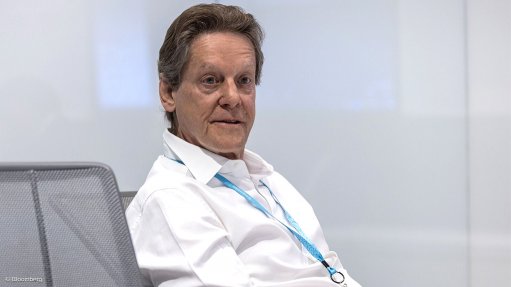
Robert Friedland
Photo by: Bloomberg
TSX-listed Ivanhoe Mines has quadrupled its exploration budget for 2024 to $90-million, with exploration activities to be primarily focused on the 2 654 km2 Western Foreland project in the Democratic Republic of Congo (DRC).
The Western Foreland project is adjacent to Ivanhoe’s successful Kamoa-Kakula operation.
“The goals of this expanded exploration effort will be threefold. Firstly, we will continue to expand the Kitoko copper discovery with additional drill rigs, thereby increasing our knowledge of its substantial exploration opportunities.
“Second, we will advance our understanding of the Makoko and Kiala deposits and optimise our studies for near-term copper mine production on our majority-owned licences.
“Finally, we will continue to evaluate high-priority targets across the Forelands, based on our fast-evolving proprietary database and geologic models for additional tier-one, high-grade copper discoveries,” says Ivanhoe founder and co-chairperson Robert Friedland.
The quadrupling of the exploration budget follows the recent announcement by Ivanhoe of the geologically significant and high-grade Kitoko copper discovery at Western Foreland, as well as the declaration of a maiden mineral resource estimate for the Makoko and Kiala copper discoveries.
Ivanhoe notes that Kitoko’s copper mineralisation is hosted in near flat-lying siltstone of the lower Grand Conglomerate, similar to the geologic setting observed at the Kamoa, Kakula, Makoko and Kiala high-grade, sedimentary copper discoveries.
“All of these discoveries, including Kitoko, in the Western Foreland share the same characteristics of mineralisation, being bottom-loaded with the highest copper grades occurring at the base of each sedimentary, copper-mineralised horizon,” it points out.
It explains, however, that the Kitoko discovery exhibits two “remarkably different” characteristics.
Firstly, the mineralisation is hosted within the Grand Conglomerate, directly overlying the Kibaran Basement rocks with no underlying Mwashia sandstones.
“This is significant as Ivanhoe Mines’ geology team previously conceived that the sandstones are the primary sedimentary aquifer allowing the circulation of oxidised copper-bearing basinal fluids, which precipitated copper when they were brought into contact with overlaying pyrite-rich reduced sediments.
“The remarkable Kitoko discovery proves the potential for copper mineralisation to occur across a greater variety of underlying aquifer conditions rather than being limited to areas where the Mwashia sandstones are present,” it notes.
Secondly, mineralisation at Kitoko occurs across at least two distinct, high-grade sedimentary horizons. This emphasises the strength of the mineralising system, as sufficient copper remains in the fluid following the interaction with the lower reductant, to be able to subsequently mineralise a second horizon.
As a result, the Ivanhoe exploration model has been disrupted by the Kitoko discovery, significantly increasing the proportion of the Western Foreland that is prospective for world-class, high-grade sedimentary copper systems, Ivanhoe reports.
Ivanhoe adds that it is in discussions with potential strategic investors, including major international corporations and sovereign wealth funds, regarding matters including, but not limited to, fast-tracking the development of the Western Foreland.